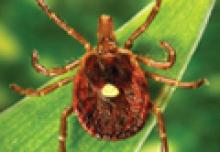The CDC has advised clinicians to be on the lookout beginning in May for cases of Heartland virus disease, which includes symptoms such as fever, leukopenia, and thrombocytopenia. In the March 28 issue of Morbidity and Mortality Weekly Report, the CDC urged health care providers to consider Heartland virus testing in patients with these symptoms, without other likely explanation, who are negative for Ehrlichia and Anaplasma or who have not responded to doxycycline.
Heartland virus disease was first identified in 2009 through two cases in Missouri. Both patients were farmers who were hospitalized with fever, leukopenia, and thrombocytopenia. The virus was presumed then to be tick-borne.
In 2012 and 2013, six confirmed cases of Heartland virus disease were reported; four patients required hospitalization, and one with comorbidities died. Five cases occurred in Missouri, and the remaining case was in Tennessee; all occurred in men ages 50 and older. The cases were reported from May to September, with half reported in May.
The disease is confirmed through laboratory evidence of recent Heartland virus infection, along with a clinically compatible illness, defined as a fever of 100.4° F or greater, white blood cell count below 4,500 cells/mm3, and platelet count less than 150,000/mm3. Other reported symptoms have included fatigue, anorexia, headache, nausea, myalgia, and arthralgia.
In 2013, Heartland virus was isolated for the first time from the lone star tick (Amblyomma americanum), which has a wide distribution in the United States and is a known vector of other diseases. A CDC report from 2003 warned that the virus’s importance would likely grow as a vector of zoonotic pathogens affecting humans because of environmental and demographic factors, and that cases of human disease mediated by A. americanum would increase.
Because no medication exists to prevent or treat Heartland virus disease, insect repellent and long-sleeved clothing are recommended for prevention, along with avoidance of bushy or wooded areas. People exposed to these environments should perform tick checks after spending time outdoors, the CDC said.
Daniel M. Pastula, MD, from the University of California, San Francisco, Medical Center, contributed to the report on Heartland virus. Clinicians with questions may contact state health departments or the CDC Arbovirus Diseases Branch, at 970-221-6400.
—Jennie Smith


